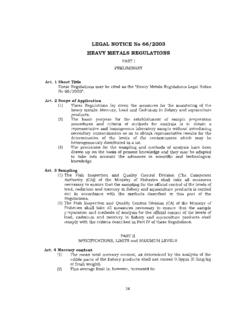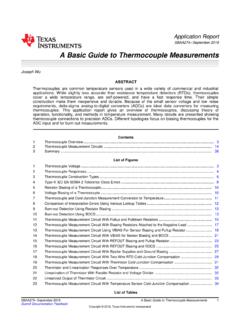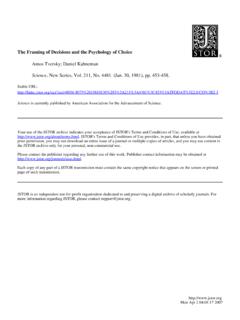Transcription of Procedures for Evidence Collection, Handling, and Storage
1 Exhibit 1 445 FW 3 Page 1 of 23 04/30/19 LAW ENFORCEMENT Supersedes Exhibit 1, 445 FW 3, 05/19/2006 Exhibit 1 445 FW 3 Procedures for Evidence Collection, Handling, and Storage TABLE OF CONTENTS Sections: 1 Purpose 2 Authorities 3 Definitions/Types of Evidence 4 Fragile/ trace Evidence 5 Recording/Documenting Seized Evidence 6 Digital Evidence Handling Procedures 7 Evidence Collection Procedures 8 Documenting Evidence 9 Packaging Evidence 10 Care, Custody, and Control of Seized Property 11 Evidence Storage Log 12 Chain of Custody 13 Transfer of Evidence 14 Receipt of Evidence 15 Disposition of Evidence 1. Purpose This exhibit provides step-down implementation Procedures for the policy in 445 FW 3. It provides minimum standards for the responsibilities, Procedures , and guidelines to ensure the integrity of the chain of custody of Evidence which Fish and Wildlife Service (Service) officers collect, record, store, and dispose of.
2 The information in the following sections give Service officers general guidance on accepted techniques they should use to ensure that Evidence is collected, documented, preserved, and handled in an integral manner and in accordance with the Rules of Evidence for United States Courts and Magistrates. Due to the variability of crime scenes and Evidence types we describe later in section 3, Service officers may refer to the guidelines in Crime Scene Investigation, a guide developed collaboratively by the Department of Justice (DOJ) Bureau of Justice Assistance (BJA), the National Institute of Justice (NIJ), and the National Forensic Science Technology Center (NFSTC). The guide provides industry standard Procedures relative to the collection, preservation, and handling of Evidence appropriate for various crime scenes and circumstances. In addition to the guidance in this exhibit, Service offices who control Evidence Storage facilities may develop their own Standard Operating Procedures (SOP), as appropriate, to address Exhibit 1 445 FW 3 Page 2 of 23 04/30/19 LAW ENFORCEMENT Supersedes Exhibit 1, 445 FW 3, 05/19/2006 specific, localized issues relative to the unique station.
3 The office should develop such SOPs in a memorandum that they distribute to their appropriate field personnel. These SOPs should complement, not contradict, the Procedures in this exhibit. 2. Authorities The Service issued this exhibit to implement policies in 446 Departmental Manual (DM) 7 and 445 FW 3. 3. Definitions / Types of Evidence A. Introduction and General Definitions. This section defines and describes categories of physical Evidence Service officer s may encounter. It also provides general guidelines for recognizing, preserving, recording, marking, tagging, and packaging physical Evidence items. It includes brief instructions for handling fragile items and other specific types of physical Evidence . For more detailed packaging and shipping Procedures , Service officers should consult Service Manual chapter 448 FW 1 for additional information. Following are three general definitions of terms we use throughout the exhibit: (1) Law Enforcement Officer (LEO).
4 An LEO is a Service employee sworn and commissioned to enforce criminal statutes and authorized to carry firearms, execute and serve warrants, search, seize, make arrests, and perform such duties as authorized by law. (2) Service Officer. A Service officer is any designated Office of Law Enforcement (OLE) or Division of Refuge Law Enforcement (DRLE) employee who has responsibility for and has been properly trained in the collection and processing of Evidence , which includes, but is not limited to: LEOs, OLE Conservation Officers, DRLE supervisors, Federal Wildlife Officers and Zone Officers, Wildlife Inspectors, Wildlife Inspector Assistants, Evidence Technicians, and Evidence Custodians. (3) Evidence . Evidence is material collected in the course of an investigation for purposes of proving violations of law and establishing the facts surrounding such violations. Evidentiary material can be testimonial, documentary, or physical in nature. B.
5 Definition of Physical Evidence . Physical Evidence is any object, or physical characteristic of an object, that the Service can use to establish the commission of a violation or to establish a link between the suspect, the victim, and the crime scene. Physical Evidence also includes any object, or impression of an object, that a subject takes from or leaves at a crime scene or which is otherwise related to a violation. C. Purpose of Physical Evidence Collection. Service officers investigate violations to determine facts and bring suspected violators to justice. Properly collecting and evaluating appropriate physical Evidence helps an officer determine the accuracy of statements from witnesses and document the occurrence and the sequence of events of an unlawful act. Exhibit 1 445 FW 3 Page 3 of 23 04/30/19 LAW ENFORCEMENT Supersedes Exhibit 1, 445 FW 3, 05/19/2006 D.
6 Categories of Physical Evidence . The categories below describe the most common types of Evidence an officer is likely to encounter. This list is not all inclusive. Depending on the circumstances of the investigation, almost any physical object can be Evidence . It is the responsibility of the investigator to recognize the critical elements of a violation and to thoroughly search for all relevant items of physical Evidence necessary to document the violation. (1) Ammunition and Spent Projectiles. Such Evidence includes loaded cartridges and shells, spent casings, bullets and shot, shot patterns, and arrows. (2) Bones, Teeth, Beaks, Claws, and Horns. Such Evidence includes animal parts and products. (3) Blood. Blood Evidence includes wet blood, dried blood chips and scrapings, and blood-stained articles. (4) Documents. Document Evidence includes licenses, invoices, permits, and other documents in which the officer questions their origin, authenticity, or possible alterations, as well as documents that tend to substantiate a violation.
7 (5) Electronic Devices. Electronic devices include, but are not limited to, GPS devices, cell phones, tablets, computers, and digital Storage devices that can retain vast amounts of information and potential digital Evidence . Digital Evidence is any information or data of value to an investigation that is stored on, received by, or transmitted by an electronic device. (6) Equipment and Supplies. Such Evidence may include tools, traps, nets, fishing tackle, bait, lures, containers, and other materials the officer suspects were used to take or transport wildlife illegally. (7) Explosives. Such Evidence includes gunpowder, dynamite compounds, grenades, and other explosive devices. (8) Feathers. Feather Evidence includes down, feathers, and feather products. (9) Plants. Plant Evidence includes all species of plants and their parts and derivatives whether live, dried, cut, or processed. (10) Fracture Evidence . Sometimes called jig-saw puzzle Evidence , fracture Evidence may include pieces of broken glass, fractured metal and plastic vehicle parts, torn pieces of paper, bone chips, and paint chips.
8 (11) Gunshot Residues. Such Evidence includes gunpowder patterns, gunpowder and primer residues found on the hands or clothing of subjects, and residues found on firearms and in wounds. Exhibit 1 445 FW 3 Page 4 of 23 04/30/19 LAW ENFORCEMENT Supersedes Exhibit 1, 445 FW 3, 05/19/2006 (12) Hair and Fibers. Hair and fiber Evidence includes loose hairs from human suspects and animals, loose fibers, and hair or fiber products. (13) Hides and Furs. Such Evidence includes raw and tanned hides and furs, as well as leather and fur products. (14) Impression Marks. Impression marks are produced by shoes, boots, tires, and other hard objects into a soft, impressionable surface such as dirt, mud, snow, asphalt, and wood. (See section 4 for more information on preserving fragile Evidence .) (15) Latent Prints. Prints are produced by the friction ridge deposits (oils, salts, and soluble proteins) of fingers, palms, and feet.
9 (See section 4 for more information on preserving fragile Evidence .) (16) Poisons. Evidence of poisons includes poisons in liquid or powder form, materials and methods used to deliver poisons, and poison residues in blood, tissues, and organs. (17) Recordings. Recording Evidence includes photographic negatives, digital imagery, video tapes and/or digital video recordings, and audio tapes and/or audio recordings produced by suspects, witnesses, or investigating officers. (18) Serial Numbers and Tags. Such Evidence includes possibly altered serial numbers on weapons, vehicles, vessels, and aircraft and possibly forged, altered, or re-used animal carcass tags. (19) Tissue and Organs. Such Evidence includes fresh, frozen, and processed meats and organs, viscera, eggs, and decayed tissues. (20) Tool Marks. Tool marks are impression or striation marks made by a tool edge coming into contact with a relatively soft surface such as wood, plastic, or soft metals.
10 (21) trace Evidence . trace Evidence is a miscellaneous category that includes minute or microscopic items of Evidence such as soil particles, glass and metal fragments, and unknown powders. (22) Vehicles, Vessels, and Aircraft. Such Evidence includes any vehicle, vessel, or aircraft an officer suspects was used to commit a wildlife violation. (23) Weapons. Weapons Evidence primarily includes rifles and pistols, but also may include bows, crossbows, spears, knives, clubs, and other implements the officer suspects were used to cause injury or death. (24) Whole Animals. Whole animal Evidence includes whole animal specimens, whether alive, wounded, dead, or preserved. (25) Wound Characteristics. Wound Evidence includes cut-out wounds, photographs of wounds, and wound contents. Exhibit 1 445 FW 3 Page 5 of 23 04/30/19 LAW ENFORCEMENT Supersedes Exhibit 1, 445 FW 3, 05/19/2006 E.








